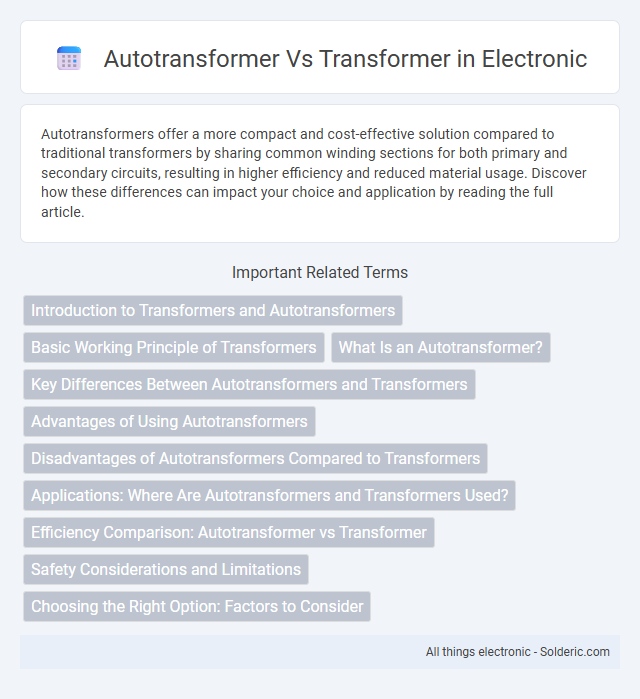Autotransformers offer a more compact and cost-effective solution compared to traditional transformers by sharing common winding sections for both primary and secondary circuits, resulting in higher efficiency and reduced material usage. Discover how these differences can impact your choice and application by reading the full article.
Comparison Table
| Feature | Autotransformer | Transformer |
|---|---|---|
| Winding Structure | Single winding with taps | Separate primary and secondary windings |
| Electrical Isolation | No electrical isolation between input and output | Provides full electrical isolation |
| Size and Weight | Smaller and lighter due to less copper | Larger and heavier |
| Efficiency | Higher efficiency, less copper loss | Lower efficiency compared to autotransformer |
| Cost | Lower cost due to reduced materials | Higher cost due to more materials and complexity |
| Voltage Transformation Range | Limited to small voltage changes | Wide voltage transformation range |
| Typical Applications | Voltage regulation, motor starting | Power distribution, isolation purposes |
| Safety | Lower safety due to lack of isolation | Higher safety with isolation |
Introduction to Transformers and Autotransformers
Transformers are electrical devices designed to transfer electrical energy between circuits through electromagnetic induction, typically featuring separate primary and secondary windings for voltage conversion. Autotransformers differ by having a single winding that acts as both the primary and secondary, sharing part of the winding for voltage adjustment, which makes them more compact and efficient for certain applications. While traditional transformers provide electrical isolation, autotransformers lack isolation but offer advantages in size, cost, and efficiency in voltage regulation between similar voltage levels.
Basic Working Principle of Transformers
Transformers operate on the principle of electromagnetic induction, where an alternating current in the primary coil generates a magnetic field that induces a voltage in the secondary coil, enabling electrical energy transfer between circuits. An autotransformer uses a single winding that acts as both the primary and secondary, with a portion of the winding common to both sides, allowing voltage adjustment with fewer materials and greater efficiency. Conventional transformers have separate primary and secondary windings that provide electrical isolation but typically result in larger size and higher cost compared to autotransformers.
What Is an Autotransformer?
An autotransformer is a specific type of electrical transformer with a single winding that acts as both the primary and secondary sides, sharing common turns. It offers efficient voltage regulation in applications where the input and output voltages are close in value, resulting in reduced size, weight, and cost compared to traditional transformers. Your equipment benefits from an autotransformer's compact design and improved efficiency in voltage step-up or step-down scenarios.
Key Differences Between Autotransformers and Transformers
Autotransformers use a single winding that acts as both the primary and secondary, whereas traditional transformers have separate primary and secondary windings, resulting in differences in construction and cost. Autotransformers provide voltage transformation with higher efficiency and reduced size but lack electrical isolation between input and output, which transformers inherently offer. Key distinctions include autotransformers' limited use in applications requiring isolation and transformers' suitability for handling higher voltage differences safely.
Advantages of Using Autotransformers
Autotransformers offer significant advantages such as reduced size, lower cost, and higher efficiency compared to traditional transformers due to their shared winding design. The reduced copper and core material requirements lead to less energy loss and improved voltage regulation, making autotransformers ideal for applications like voltage step-up or step-down in power transmission. Their ability to handle higher currents with lower leakage reactance enhances performance in electrical distribution systems.
Disadvantages of Autotransformers Compared to Transformers
Autotransformers have limited isolation between the primary and secondary windings, which can pose safety risks and increase the potential for electrical noise interference compared to conventional transformers. They also lack voltage regulation capabilities under varying load conditions, leading to less stable output voltage and increased susceptibility to voltage fluctuations. Furthermore, autotransformers are unsuitable for applications requiring galvanic isolation, making them less versatile than traditional transformers in critical electrical systems.
Applications: Where Are Autotransformers and Transformers Used?
Autotransformers are commonly used in applications requiring voltage regulation and efficient power transfer, such as motor starting, voltage step-up or step-down in power distribution, and audio equipment. Transformers find widespread use in electrical isolation, power transmission, and voltage transformation in high-voltage systems, ensuring safety in sensitive electronic devices and large-scale industrial setups. Your choice between autotransformers and transformers depends on the need for isolation, voltage levels, and application-specific efficiency requirements.
Efficiency Comparison: Autotransformer vs Transformer
Autotransformers typically offer higher efficiency than traditional transformers due to reduced copper losses and smaller size, resulting from their shared winding design. Their ability to use a single winding for both primary and secondary reduces material costs and energy dissipation, which enhances overall performance in voltage regulation applications. You can expect autotransformers to provide greater efficiency in scenarios where voltage transformation ratios are close, while traditional transformers remain preferable for isolation and safety purposes.
Safety Considerations and Limitations
Autotransformers offer a more compact and efficient solution but lack electrical isolation, increasing the risk of shock and making them less suitable for sensitive equipment or applications requiring full isolation. Traditional transformers provide complete electrical isolation between primary and secondary windings, enhancing safety by preventing direct current flow and reducing electrical noise interference. When selecting between an autotransformer and a traditional transformer, consider your safety requirements and limitations related to isolation and potential fault conditions.
Choosing the Right Option: Factors to Consider
Selecting between an autotransformer and a traditional transformer depends primarily on voltage requirements, efficiency, and cost-effectiveness. Autotransformers are ideal for applications needing small voltage adjustments with higher efficiency and reduced size, while traditional transformers provide galvanic isolation crucial for safety and noise reduction. Consider the application's electrical isolation needs, voltage ratio, and budget constraints to determine the most suitable transformer type.
autotransformer vs transformer Infographic

 solderic.com
solderic.com